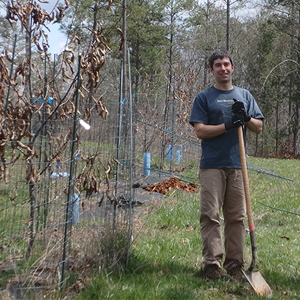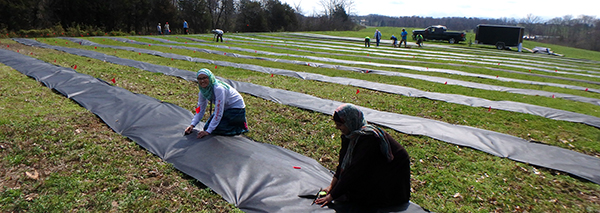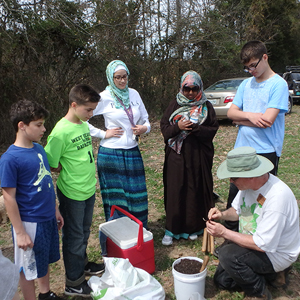
UT-Chattanooga graduate student, Taylor Perkins helping to plant the seedlings.
TACF volunteers in the southern region have been busy with some early spring plantings. On March 18, volunteers from Georgia and Tennessee banded together to add plantings to the Phytophthora orchard at Lake Allatoona in Cartersville, Georgia. Regional Science Coordinator, Ed Schwartzman, and TACF Board Member, Dr. Hill Craddock collaborated on the planting, getting an early start on a pleasant Saturday morning. The team planted approximately 65 B1 chestnuts that had been successfully pre-screened for Phytophthora resistance at the UT-Chatanooga greenhouse. As the Lake Allatoona site is infested with Phytophthora cinnamomi, these seedlings will be monitored to assess for Phytophthora resistance in the wild and also evaluated to see if their observed resistance from the greenhouse screening correlates with survival in the field.
Despite the rocky ground, volunteers managed to dig holes, plant the year-old seedlings, and reestablish tree shelters and wire fencing around the newly planted seedlings. Georgia volunteer, Wayne Mead, came out with his 89-year old dad, Allen, and both put in a yeoman’s effort. The volunteer award of the day goes to Taylor Perkins, Dr. Craddock’s recently graduated Master’s student, who put in a long day of hard work while fighting the flu. Results of the planting will inform future efforts to develop Phytophthora-resistant chestnut crosses and provide insight into the efficacy of current screening approaches.

Volunteers planting B3F2 seeds.

Dr. Hill Craddock prepares volunteers for the planting.
Approximately 235 B3F2 seeds from four new crosses were direct seeded into an orchard at Kate’s Bluff Farm in Dandridge, TN. The four lines were developed from Meadowview backcross trees derived from the Nanking Chinese cultivar crossed with native American trees from Tennessee, Georgia, and North Carolina. Trees derived from the Nanking line have potential to inherit some level of both blight resistance as well as resistance to Phytophthora root rot disease.
Volunteers chipped in to lay down weed fabric, prepare holes, plant the nuts, and accommodate tree shelters around the freshly planted seeds. Dr. Hill Craddock kept watch to make sure all the seeds were properly planted, and Paola Zannini kept track of the data and developed the orchard map. The ultimate success rested on Tom Saielli, who pollinated and made the crosses at Meadowview in 2016.
All involved in the planting have high hopes for its success, given the determined effort invested by staff and volunteers and the excellent site conditions afforded at the Kate’s Bluff Orchard.
